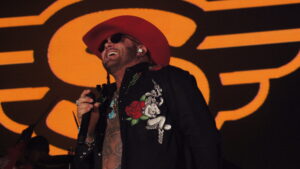Rarely does an album come along that changes the fabric of the music industry. And even rarer is the rock album that actually has pop sensibility and melodic hooks in tow as well. Hybrid Theory wasn’t your ordinary album, though. In fact, it arrived at the perfect time in many ways. One, it arrived as CD sales were hitting their peak – but also just before the advent of Limewire and other file-sharing services became in vogue (Napster may have existed already, but high-speed Internet was still developing at this point). Two, it arrived right when nu-metal was reaching a peak of popularity. After all, Korn appearing on South Park the year previously as well as Korn + Limp Bizkit’s Woodstock ’99 infamy helped bring the genre to the mainstream.
There were also other factors that into the album’s success. Smartly, its seemingly family-friendly nature contained no profanity, which meant that unlike most of their peers, they were able to capture a wide variety of audience members. Specifically, young fans that were nonetheless often able to relate to the album’s relatable stories of the every day emotions we experience and encounter as humans – rage, betrayal, even allusions to the abuse that the late Chester Bennington endured growing up. Basically, it was nu-metal made a little more palatable, but there’s more to Hybrid Theory than that, of course.
An album where every song could’ve been a legitimate single (seriously), Hybrid Theory is also the last rock album to be the year’s best-selling record in the world (when it did so in 2001). Worldwide, it’s sold around as many copies as generational albums like The Joshua Tree and Nevermind, and it’s just as essential. Quite a few songs dated back to the band’s pre-Chester Bennington days, when they were known as Hybrid Theory and even Xero, especially certain sections of “A Place For My Head”, “Runaway”, and even the instrumental “Cure For The Itch”, where DJ Hahn gets to shine. The latter continued the band’s tradition of including at least one instrumental track on each album, and also provided an opportunity to show off their instrumental skills and electronic influences. In particular, tracks like megahit “Crawling” showcase their electronic and even synthpop influences being pushed to the forefront, with Depeche Mode being a prominent influence on the song’s composition and sound.
When we say every song on Hybrid Theory could’ve been a single, that’s not an exaggeration. While four singles were officially released from the record (“In The End”, “Papercut”, “Crawling”, and “One Step Closer”), plenty of other songs saw some success. Especially “Points Of Authority” and “Runaway”, often considered two of the most iconic songs off Hybrid Theory. Interestingly, the former song also featured on the soundtrack to Adam Sandler’s Little Nicky, which might actually be one of the best soundtracks of the era.
While the 20th anniversary edition of the record featured a lot of songs that could’ve feasibly made the album, it was smart to package all of it in a 38 minute vehicle. Not a second is wasted, either. From The Dust Brothers-assisted, relationship-tackling “With You” to the automatically memorable “A Place For My Head” (which describes a situation where someone takes from you without giving you anything in return), it’s interesting how Brad Delson’s guitar riffs are fairly simple – yet fit each song well. It would be a mistake not to mention the album’s hip-hop influence as well, with Mike Shinoda and Chester Bennington’s synergy being a very important part of why it succeeds. Particularly on “A Place For My Head” and “Points Of Authority”, where the songs abruptly shift into sonic violence – but with still huge hooks that have had people singing along for over 20 years now.
Clearly, this was a band with a plan to succeed, with even their earliest movements (utilizing the Internet and chat rooms to connect was a big one) being intentional. Obviously, it spilled over into the music. So too was the band’s chemistry as a whole, and there’s no better euphoria as a fan of music than realizing that someone might actually understand you. It’s a big reason why nu-metal was (and still is) such a profitable genre of music, too. It’s just that it was put to action in different ways, especially with bands like Korn and Papa Roach also confronting mental health issues before it was cool to do so.
With just enough edge to appeal to heavy music fans and the merging of several hybrid (hah!) genres and influences, it’s not a huge surprise (in retrospect) that Hybrid Theory exploded like it did. By appealing and describing the basic emotions that many of us experience every day and packaging it in a style that was done with a revolutionary mindset, it’s provided an important template that many rock bands still try and emulate. It’s also quite the gateway album for people getting into heavier music even now, much like it was upon its 2000 release. You were probably the target demographic for the record, too.





More Stories
Knocked Loose’s “Don’t Reach For Me” has entered Spotify’s USA Viral 50 chart
An underrated Deftones song from ‘Saturday Night Wrist’ is getting more attention, thanks to their Coachella performances
Brothers in Music: The Unforgettable Journey of the Chrisagis Brothers